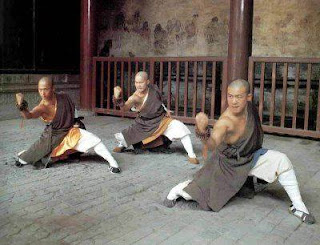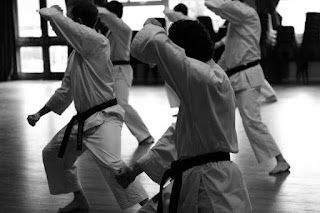What happens if you take away kihon (basics)
Very soon my number 1 Japanese friend and Senpai Miki Yamaguchi is going to grade for her Nidan, or Second Degree Black Belt for those of you who do not do Karate.
We have spoken a lot about her training and what is required of her in the upcoming grading for the last two months now. One thing that comes up with every conversation is how much work her Senseis (yes- she trains with at least 3 every week!) say there needs to be done on her kihon or basics.
Now- Karate and Kung Fu people can relax- I am not talking to you now. We know very well why this is important.
To those, however, that are quick to say that it is useless to spend time on these "fixed forms" and "rigid techniques" and probably also that they won't work in the cage or- yeah, you know it, on the street- I think there is something you should know about original Asian martial arts.
To those, however, that are quick to say that it is useless to spend time on these "fixed forms" and "rigid techniques" and probably also that they won't work in the cage or- yeah, you know it, on the street- I think there is something you should know about original Asian martial arts.
You see- the number 1 thing that I got reminded of quite recently is that the bodies and minds of many untrained people are simply not suited for fighting.
Moves like what we see in videos like these do not come naturally.
https://youtu.be/EqR3nrT6OGY
https://youtu.be/EqR3nrT6OGY
Hell! From what I have seen lately not even punching properly comes natural to a lot of people...
Fortunately- the body has a way to adapt to become suitable for the work that you give it to do.
At first many of the stances you are made to adopt feel uncomfortable, but later on you will not only become comfortable adopting these stances, but also find that you can move to and away (and in some cases even around) your opponent with great ease.
My number 1 fault to find with the attacks of an untrained individual that claims to hit really hard (and probably does...) is that a lot of energy goes to waste in delivering those blows.Fortunately- the body has a way to adapt to become suitable for the work that you give it to do.
At first many of the stances you are made to adopt feel uncomfortable, but later on you will not only become comfortable adopting these stances, but also find that you can move to and away (and in some cases even around) your opponent with great ease.
After a long while of learning the proper technique for punching and kicking with kihon training and then repeating these techniques over and over again over years of time you start realising that your attacks have become a lot more efficient.
Grappling arts are not excluded from this either. My favourite grappling art in this world is Aikido.
Why I like it more than Judo is because it spends a lot more time on teaching proper stance, posture and overall technique than Judo seems to do these days.
An uninitiated observer may think that getting flipped over with a flick of the wrist is a load of BS, but if you took the time to actually learn the technique you'd realise how little many non-martial arts trained people know about body mechanics.
To obtain that ability, however, requires a lot of practice in that seemingly boring aspect of the art...
To take things further, though-
In learning Shaolin Kung Fu and Taijiquan you may find that without qigong and what we call "force training" your movements would feel useless and would most likely be as well.

I have found that repeated practice of Karate kihon can actually give the same benefits of Shaolin force training. This goes for kata as well.
:max_bytes(150000):strip_icc()/kung_fu_485721175-57c484205f9b5855e5c6ca01.jpg)
Taolu (what kungfu people call kata) is already known as a means of force training. Still- although Karate's kata provides similar benefits and in some cases even incorporates the same type of breathing (which is important from a qigong point of view), I have not seen anyone yet who wrote about this aspect of kata yet or even acknowledged that it exists. This particular as pect is real enough in Karate, though. Ask Goju Ryu student who has learnt Sanchin kata at a registered Goju Ryu dojo how that kata gets practiced in class and you will know what I mean.
No! Wait! We have Youtube, right?
Just look here:
https://youtu.be/amMD5IbxgFI
Didn't take me long to find that...

What you have seen in the video is very similar to how Chinese martial artists develop the ability known as "Iron Shirt" by which the body can receive blows without injury.
It does not happen after a day, though.
Besides that-
Regular kihon training simply makes your techniques look a lot better.
No offence to any of the students appearing in the first of the next two videos, but you can't argue with the difference between this-
https://youtu.be/mpNq6qa3s9w
and this-
https://youtu.be/6NUs8Lmn1sA
So- if you feel that kihon is unnecessary, outdated or maybe just too much of a bother to spend time on- I will always differ, because martial arts without it just looks crappy...
Well- that's it from me today. Enjoy the weekend and have a great week ahead!






Comments
Post a Comment